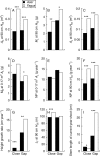Do interspecific differences in sapling growth traits contribute to the co-dominance of Acer saccharum and Fagus grandifolia?
- PMID: 17942590
- PMCID: PMC2701832
- DOI: 10.1093/aob/mcm259
Do interspecific differences in sapling growth traits contribute to the co-dominance of Acer saccharum and Fagus grandifolia?
Abstract
Background and aims: Acer saccharum and Fagus grandifolia are among the most dominant late-successional tree species in North America. The influence of sapling growth responses to canopy gaps on the co-dominance of the two species in an old-growth forest in southern Quebec, Canada was examined. Two predictions were evaluated: (a) F. grandifolia is more shade tolerant than A. saccharum due to greater sapling leaf area and net production per sapling in closed-canopy conditions; and (b) the height growth rate of A. saccharum in canopy gaps is greater than that of F. grandifolia due to increased net production per sapling.
Methods: Sapling crown allometry, net production and height growth rates were compared between and within the two species in closed canopy vs. canopy gaps. Standardized major axis regression was used to analyse differences in crown allometry.
Key results: F. grandifolia had greater crown projection, sapling leaf area and net production rate per sapling than A. saccharum in closed-canopy conditions. In response to canopy gaps, net production per sapling increased to the same degree in both species. The net production per sapling of F. grandifolia thus was much greater than that of A. saccharum in both canopy gap and closed-canopy conditions. The height growth rate of both species increased in canopy gaps, but the degree of increase was greater in F. grandifolia than in A. saccharum.
Conclusions: F. grandifolia regenerated more successfully than A. saccharum in both closed-canopy conditions and canopy gaps, which indicates that the co-dominance of the two species cannot be maintained simply by interspecific differences in shade tolerance and growth in gaps. Previous research showed that although Fagus and Acer shared dominance at this site, their relative dominance shifted with edaphic conditions. This suggests that the widespread co-dominance of the two species in eastern North American forests is maintained by the joint influence of canopy disturbance and species-specific responses to the heterogeneity of moisture and fertility regimes within forested landscapes.
Figures





Similar articles
-
Codominance of Acer saccharum and Fagus grandifolia: the role of Fagus root sprouts along a slope gradient in an old-growth forest.J Plant Res. 2010 Sep;123(5):665-74. doi: 10.1007/s10265-010-0312-y. Epub 2010 Feb 25. J Plant Res. 2010. PMID: 20182904
-
Growth and posture control strategies in Fagus sylvatica and Acer pseudoplatanus saplings in response to canopy disturbance.Ann Bot. 2011 Jun;107(8):1345-53. doi: 10.1093/aob/mcr058. Epub 2011 Mar 28. Ann Bot. 2011. PMID: 21444338 Free PMC article.
-
Canopy gradients in leaf functional traits for species that differ in growth strategies and shade tolerance.Tree Physiol. 2017 Oct 1;37(10):1415-1425. doi: 10.1093/treephys/tpx048. Tree Physiol. 2017. PMID: 28486656
-
Shade adaptation and shade tolerance in saplings of three Acer species from eastern North America.Oecologia. 1990 Sep;84(2):224-228. doi: 10.1007/BF00318275. Oecologia. 1990. PMID: 28312756
-
Thirty-two years of change in an old-growth Ohio beech-maple forest.Ecology. 2013 May;94(5):1165-75. doi: 10.1890/11-2199.1. Ecology. 2013. PMID: 23858656
Cited by
-
Growth, allometry and shade tolerance of understory saplings of four subalpine conifers in central Japan.J Plant Res. 2014 Mar;127(2):329-38. doi: 10.1007/s10265-013-0610-2. Epub 2013 Dec 6. J Plant Res. 2014. PMID: 24310614
-
Codominance of Acer saccharum and Fagus grandifolia: the role of Fagus root sprouts along a slope gradient in an old-growth forest.J Plant Res. 2010 Sep;123(5):665-74. doi: 10.1007/s10265-010-0312-y. Epub 2010 Feb 25. J Plant Res. 2010. PMID: 20182904
References
-
- Arii K, Lechowicz MJ. The influence of overstory trees and abiotic factors on the sapling community in an old-growth Fagus–Acer forest. Ecoscience. 2002;9:386–396.
-
- Arii K, Hamel BR, Lechowicz MJ. Environmental correlates of canopy composition at Mont St. Hilaire, Quebec, Canada. Journal of the Torrey Botanical Society. 2005;132:90–102.
-
- Baraloto C, Goldberg DE, Bonal D. Performance trade-offs among tropical tree seedlings in contrasting microhabitats. Ecology. 2005;86:2461–2472.
-
- Beaudet M, Messier C. Growth and morphological responses of yellow birch, sugar maple, and beech seedlings growing under a natural light gradient. Canadian Journal of Forest Research. 1998;28:1007–1015.
-
- Bigelow SW, Canham CD. Community organization of tree species along soil gradients in a north-eastern USA forest. Journal of Ecology. 2002;90:188–200.
Publication types
MeSH terms
LinkOut - more resources
Full Text Sources
Miscellaneous

